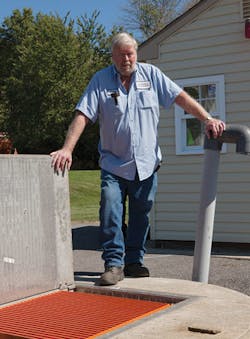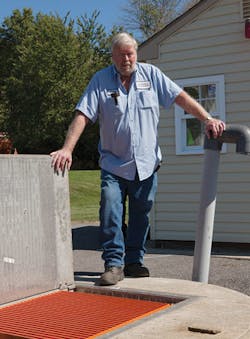Yankee Ingenuity Solves Wet Wipes Problem
Wet wipes are a handy commodity in households, hospitals, healthcare centers, schools and anywhere people need a quick tidy-up. But the $2 billion wet-wipes market and the two million lift pump stations in the U.S. may be at an impasse - at the bottom of wet well lift stations. It’s here that wipes, once flushed, can form large, knotted balls of material that clog lift station pumps and interfere with the level controls, causing maintenance trauma for sewer department personnel. In one Connecticut town, a savvy sewer department foreman took the time to find the exact cause of the problem - and identify a simple, effective solution.
Curtis Rooth, sewer department foreman for Cromwell, Conn. (population: 14,000), was keenly aware of the problem. Normally, his lift station pumps fill to about 10 feet of water, start the on cycle and pump the water/sewage. The pumps shut off when levels return to about three feet.
But one of the neighborhood lift stations would not always evacuate the collected water. The expensive solution was to send a repair crew and vacuum truck to clear the offending debris from the floor and the pumps. Seeking a less costly solution, Rooth observed that the wipes and other non-flushable material collected during the station’s off cycle and combined with grease to form a large, knotted clump. In addition, the clump would dislodge and move the liquid level transducer, resulting in a bad water-level signal and poor pump control. He suspected the clump formed at the grinder pumps inlet, which sometimes prevented enough water from entering the pump, causing it to cavitate, which could shorten pump life.
Air-powered Mixer Moves Wipes Through Pumps
Rooth’s initial idea was to try an electric submersible mixer with fan-like blades. The wet wipes collected and stuck on the blades during the off period, causing an excessive load on the motor and heavy vibration when running. Another concern was how to safely install the electric mixer without the mixer accidentally cutting electrical wires.
Then he tried the GridBee® AP500 mixer from Medora Corporation. Since the unit is air-powered, there are no issues with electrical safety or mechanical rotating components. The installation also does not require fastening the mixer to the wall or the floor. The unit is simply lowered with a chain, either all the way to the bottom of the wet well or suspended from the chain slightly above the bottom.
The AP500 mixer creates an upward, mixing flow from the bottom of the lift station. A non-clogging diffuser and a flow-concentrating outlet effectively scour the floor area of debris and send a one-foot-diameter stream of water upward. This flow keeps the wet wipes from forming clumps, allowing the wipes and any grease that has been broken up to easily pass through the pump.
Since Rooth installed the AP500 mixer, the lift station has performed as expected with very clear water in the well. His Yankee ingenuity found the source of the problem; AP500 mixers took care of the rest.
Medora Corp. is exhibiting at WEFTEC.16, Booth 1145. For more information, visit www.solarbee.com.



